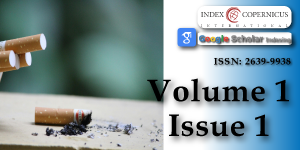Addiction to self-strangulation: a case-report
Main Article Content
Abstract
Introduction: DSM-5 mentions autoerotic asphyxia in the paraphilic disorders section, as a specifier for the diagnostic of sexual masochism disorder. Strangulation activities have also been observed in the “choking game”. The term “strangulation activity” is considered as more appropriate than “choking game”. While sharing a same behavior, autoerotic asphyxia and non auto-erotic strangulation activities might represent a very distinct pattern of disorders. We describe here a case report of a 25-year old male internship student who has practiced manual self-strangulation up to 40 times a day since adolescence. In the examination of this case we identify individual clinical aspects of this case in a process-based holistic case conceptualization.
Case description: The patient is a 25 years old male with a post-graduate degree who presented with a recent history of poor work performance and work-related stress during an internship. He has a concomitant history of both ketamine and cannabis use disorders, and reports urges to self-strangulate, sometimes specifically avoiding contact with friends engage in this behavior and that he has never attempted to discontinue self-strangulation. Neuropsychological assessment found a cognitive functioning below that expected given his educational level. Our intervention consists of a 3-weeks cognitive and motivational therapy program in addiction unit with associated abstinence.
Conclusion: Autoerotic asphyxia is a behavior observed not only in the context of sexual masochism disorder, but also as a specific addictive behavior, in the absence of sexual arousal, possibly as a result of emotional dysregulation.
Article Details
Copyright (c) 2017 Ameller A, et al.

This work is licensed under a Creative Commons Attribution 4.0 International License.
Hucker SJ. Hypoxyphilia. Arch Sex Behav. 2011; 40: 1323-1326. Ref.: https://goo.gl/wCfpa9
Krueger RB, Kaplan MS. Paraphilic Diagnoses in DSM-5. Isr J Psychiatry Relat Sci. 2012; 49: 248-254. Ref.: https://goo.gl/GyZkGz
Hitchcock A, Start RD. Fatal traumatic asphyxia in a middle-aged man in association with entrapment associated hypoxyphilia. J Clin Forensic Med. 2005; 12: 320-325. Ref.: https://goo.gl/NrBCgz
Quinn J, Twomey P. A case of auto-erotic asphyxia in a long-term psychiatric setting. Psychopathology. 1998; 31: 169-173. Ref.: https://goo.gl/4V8ZGu
Shields LBE, Hunsaker DM, Hunsaker JCI. Autoerotic Asphyxia: Part I. J Forensic Med. 2005; 26: 45-52. Ref.: https://goo.gl/tUjrES
Behrendt N, Buhl N, Seidl S. The lethal paraphiliac syndrome: accidental autoerotic deaths in four women and a review of the literature. Int J Legal Med. 2002; 116: 148-152. Ref.: https://goo.gl/xXNrkb
Noirhomme-Renard F, Gosset C. The “choking game” and asphyxial games: epidemiological and clinical data. Rev Médicale Liège. 2011; 66: 485-490. Ref.: https://goo.gl/AM2M84
8 Mechling B, Ahern NR, McGuinness TM. The choking game: a risky behavior for youth. J Psychosoc Nurs Ment Health Serv. 2013; 51: 15-20. Ref.: https://goo.gl/q5Uxzb
Katz KA, Toblin RL. Language matters: unintentional strangulation, strangulation activity, and the “choking game”. Arch Pediatr AdolescMed. 2009; 163: 93-94. Ref.: https://goo.gl/orYR7Q
Macnab AJ, Deevska M, Gagnon F, Cannon WG, Andrew T. Asphyxial games or “the choking game”: a potentially fatal risk behavior. Inj Prev. 2009; 15: 45-49. Ref.: https://goo.gl/nqa2D7
Ramowski SK, Nystrom RJ, Rosenberg KD, Gilchrist J, Chaumeton NR. Health risks of Oregon eighth-grade participants in the “choking game”: results from a population-based survey. Pediatrics. 2012; 129: 846-851. Ref.: https://goo.gl/kcez6Q
Bernacki JM, Davies WH. Prevention of the Choking Game: parent perspectives. J Inj Violence Res. 2012; 4: 73-78. Ref.: https://goo.gl/Dtc6dM
“Choking game” awareness and participation among 8th graders--Oregon, 2008. Centers for Disease Control and Prevention. 2010; 59: 1-5. Ref.: https://goo.gl/Lu8jzJ
Andrew TA, Fallon KK. Asphyxial games in children and adolescents. Am J Forensic Med Pathol. 2007; 28: 303-307. Ref.: https://goo.gl/sdqgie
Michel G, Bernadet S, Aubron V. Cazenave N. Des conduites à risques aux assuétudes comportementales: le trouble addictif au danger. Psychol Fr. 2010; 55: 341-353. Ref.: https://goo.gl/JsGTaf
Bernheim A, Halfon O, Boutrel B. Controversies about the enhanced vulnerability of the adolescent brain to develop addiction. Front Pharmacol. 2013; 4: 118. Ref.: https://goo.gl/1Nrrj8
Billieux J, Schimmenti A, Khazaal Y, Maurage P, Heeren A. Are we overpathologizing everyday life? A tenable blueprint for behavioral addiction research. J Behav Addict. 2015; 4: 119-123. Ref.: https://goo.gl/8irpJc
Dudley R, Kuyken W, Padesky CA. Disorder specific and trans-diagnostic case conceptualization. Clin Psychol Rev. 2011; 31: 213-224. Ref.: https://goo.gl/UDHUzt
Kardefelt-Winther D. Conceptualizing Internet use disorders: Addiction or coping process?. Psychiatry Clin Neurosci. 2016; 71: 459-466. Ref.: https://goo.gl/7GNFzo
Modelli MES, Rodrigues MS, Castro BZM, Corrêa RS. Self-induced fatal air embolism: accidental autoerotic death or suicide?. J Forensic Sci. 2013; 58: 261-263. Ref.: https://goo.gl/dnMuyq
Solarino B, Leonardi S, Grattagliano I, Tattoli L, Di Vella G. An unusual death of a masochist: Accident or suicide?. Forensic Sci Int. 2011; 204: 16-19. Ref.: https://goo.gl/Yo4fMk
Hazelwood RR, Burgess AW, Groth AN. Death during dangerous autoerotic practice. Soc Sci Med. 1981; 15: 129-133. Ref.: https://goo.gl/bjLcYr
Sauvageau A. Current reports on autoerotic deaths--five persistent myths. Curr Psychiatry Rep. 2014; 16: 430. Ref.: https://goo.gl/mJDg57
Andrew T. Les jeux d’asphyxie chez les enfants et les jeunes. in Jeu du foulard et autres jeux d’évanouissement : pratiques, conséquences et prévention. Paris: L’Harmattan. 2010; 41-43.
Zhu TH, Mio Nakamura, Benjamin F, Michael A, Jason R, et al. Obsessive-compulsive skin disorders: a novel classification based on degree of insight. J Dermatol Treat. 2017. Ref.: https://goo.gl/yXs4qU
Billieux J, Philippot P, Schmid C, Maurage P, De Mol J, et al. Is Dysfunctional Use of the Mobile Phone a Behavioural Addiction? Confronting Symptom-Based Versus Process-Based Approaches. Clin Psychol Psychother. 2015; 22: 460-468. Ref.: https://goo.gl/B15GnP

